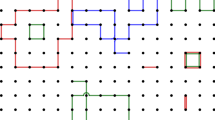Abstract
When is the numerical value of the critical point changed by an enhancement of the process or of the interaction? Ferromagnetic spin models, independent percolation, and the contact process are known to be endowed with monotonicity properties in that certain enhancements are capable of shifting the corresponding phase transition in only an obvious direction, e. g., the addition of ferromagnetic couplings can only increase the transition temperature. The question explored here is whether enhancements do indeed change the value of the critical point. We present a generally applicable approach to this issue. For ferromagnetic Ising spin systems, with pair interactions of finite range ind⩾2 dimensions, it is shown that the critical temperatureT c is strictly monotone increasing in each coupling, with the first-order derivatives bounded by positive functions which are continuous on the set of fullyd-dimensional interactions. For independent percolation, with 0<p c<1, we prove that any “essential enhancement” of the process has an effect on the critical probability, a result with applications to the question of the existence of “entanglements” and to invasion percolation with trapping.
Similar content being viewed by others
References
Y. Higuchi, Coexistence of the infinite (*) clusters: a remark on the infinite lattice site percolation,Z. Wahrsch. Ver. Geb. 61:75–81 (1982).
H. Kesten,Percolation Theory for Mathematicians (Birkhäuser, Boston, 1982).
M. V. Menshikov, Quantitative estimates and rigorous inequalities for critical points of a graph and its subgraphs,Theory Prob. Appl. 32:544–547 (1987).
M. Aizenman, J. T. Chayes, L. Chayes, J. Fröhlich, and L. Russo, On a sharp transition from area law to perimeter law in a system of random surfaces,Commun. Math. Phys. 92:19–69 (1983).
Y. Kantor and G. N. Hassold, Topological entanglements in the percolation problem,Phys. Rev. Lett. 60:1457–1460 (1988).
R. M. Burton and M. Keane, Density and uniqueness in percolation,Commun. Math. Phys. 121:501–505 (1989).
R. B. Griffiths, C. A. Hurst, and S. Sherman, Concavity of the magnetization of an Ising ferromagnet in a positive external field,J. Math. Phys. 11:790–795 (1970).
M. Aizenman, Geometric analysis ofφ 4 fields and Ising models,Commun. Math. Phys. 86:1–48 (1982).
M. Aizenman, D. Barsky, and R. Fernández, The phase transition in a general class of Ising-type models is sharp,J. Stat. Phys. 47:343–374 (1987).
G. R. Grimmett,Percolation (Springer-Verlag, New York, 1989).
J. T. Chayes, L. Chayes, and C. M. Newman, private communication.
T. E. Harris,Ann. Prob. 2:969–988 (1974);6:355–378 (1978).
C. E. Bezuidenhout and G. R. Grimmett, Exponential decay for subcritical contact and percolation processes,Ann. Prob., to appear.
D. Barsky and M. Aizenman, Percolation critical exponents under the triangle condition,Ann. Prob., to appear.
M. Aizenman, Contact processes: A short derivation of universal bounds on the critical behavior, in preparation.
Author information
Authors and Affiliations
Additional information
This paper is dedicated to J. Percus on the occasion of his 65th birthday.
Rights and permissions
About this article
Cite this article
Aizenman, M., Grimmett, G. Strict monotonicity for critical points in percolation and ferromagnetic models. J Stat Phys 63, 817–835 (1991). https://doi.org/10.1007/BF01029985
Received:
Issue Date:
DOI: https://doi.org/10.1007/BF01029985



